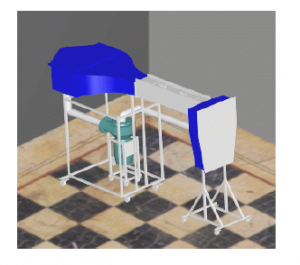Lon M. Stevens and Dr. Daniel R. Maynes, Mechanical Engineering
A water tunnel is essential for visualization, validation, and experimental analysis of the fundamental fluid dynamic behavior of flowing liquids. Water tunnels come in a variety of geometric dimensions, which are dependent upon the type of fluid flows that are of interest. It was proposed for this project that a water tunnel be designed to be used for research and instruction in the Mechanical Engineering Department. The test section of the proposed design will be three feet long, eight inches wide, and eight inches high and manufactured from transparent Plexiglas. Water will flow from one side of the tunnel to the other due to a controllable pump at a rate of 650 GPM (Gallons per Minute). Water exits at the other end of the test section to a water reservoir. The flow is then directed back through the pump to be recycled through the same process. A computer generated drawing of the preliminary design for the water tunnel that will be used by the Mechanical Engineering Department is shown below:
Figure 1: 3-D View of the computer-created water tunnel design; Figure 2: Side View of the computer-created water tunnel design
To begin the design and fabrication of this water tunnel, we completed a thorough research to find out the major and important parameters of a water tunnel so that it will function properly. Some of the parameters that we needed to come up with were: 1. the overall and basic dimensions of the water tunnel
2. how big, and what kind, of pump would be needed to supply at least 650 GPM of water
3. the devices needed in the inlet reservoir to straighten the flow of the liquid (if the flow of the liquid is not mainly straight % without a lot of disturbances such as vortices % the experiments would not be helpful nor accurate)
4. the dimensions of the structure to support the weight of the water and to allow the water tunnel to be modular – various lengths of test sections could be placed between the inlet and discharge reservoir.
We also did some research on how some of the parts, like the inlet and discharge reservoirs, would be manufactured.
With this research completed, we initiated the design of the water tunnel. We designed not only the basic dimensions of the water tunnel, but also how the tunnel would be made. A fairly complete design needed to be finished before we could continue, as we needed the approval of the Mechanical Engineering Department to buy the materials to construct the entire water tunnel. To accomplish this design process we talked to both Professors that had familiarity with the manufacturing processes that we were going to use and Professors that had knowledge of how water tunnels are made and implemented. We also ran a complete cost estimate to make sure that by manufacturing the water tunnel ourselves it would save the University enough money to justify not buying a commercially available water tunnel.
When we had arrived at the point where we could have taken the design proposal before the Department committee, there was still some doubt about how much it would cost to construct the inlet and discharge reservoirs out of fiberglass. This doubt was due to the fact that none of us on the team had ever built a complicated shape, like the inlet reservoir, out of fiberglass. At this point, as both Dr. Daniel Maynes and Dr. Jerry Bowman had $1000 already set aside for this project, we decided to build both reservoirs out of fiberglass and compare the final cost of construction to our initial estimation. If the fabrication worked out and the cost was close to our original estimation, we would then at that point take the proposal, with some physical proof, to the Mechanical Engineering Department to petition for the remaining money needed to finish building the water tunnel.
With this decision made, we bought the materials needed to create the core. (The core is basically the mold that would be used to lay the fiberglass sheets on until they were dry. After the fiberglass dried, the core would be removed.) Before I graduated we were able to construct the basic shapes of the cores. The final touches of preparing the core before the fiberglass could be laid on top of it still needed to be finished, though. After the cores are finished and the fiberglass is placed on them and are dried, Dr. Maynes should be able to present our proposal to the Mechanical Engineering Department. I feel fairly confident that, if no large problems arose while finishing up the fiberglass work, the Department will accept our petition for the money. This is due to the fact that the use of a water tunnel will not only benefit the students and faculty in the study and research of fluid flow it will also save the Mechanical Engineering Department approximately $5000 to have the tunnel built than if they would have bought a commercially available water tunnel.

